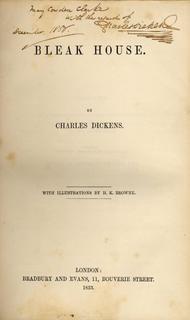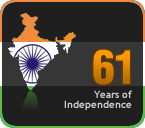Something of Myself
Thursday, October 20, 2005

'Inside Bleak House'
Bleak House is a novel that brought Mr. Charles Dickens very close to my heart. A fantastic read for those who haven't yet indulged in its(his?) pathos.
Read a very interesting article in The Guardian on BH and Dickens.
Excerpts:
H/L - Dickens' War on Filth
In his working notes for the 15th serial episode of Bleak House, Charles Dickens pondered what to do with the creation to whom every reader's heart had gone out, the pathetic street waif, Jo ("He wos wery good to me, he wos"). "Jo?" the author asked himself. "Yes. Kill him." Thus Jo went the way of Little Nell and Paul Dombey. The poor unsuspecting urchin was slaughtered by his creator as heartlessly as the turkey Scrooge ordered from another little urchin for Christmas. In May 1853, shocked Victorian readers wept inconsolably for their loss and, more importantly, signed on to Bleak House for the duration.
[...]
As a fellow serialist, Dickens would have admired the "curtain lines" (or cliffhangers), the crosscutting, the finely judged alternations of comedy, sentiment and pathos that we get today in EastEnders. As an inveterately cockney novelist - "Boz" - he would also have felt comfortable with the location. (How does Bleak House begin? With one word: "London.") (my italics)
[...]
One finds the obsession with cleanliness everywhere in Bleak House. Dickens's filthmeter is always turned on. It goes into whirring overdrive in such scenes as that of the first visit to the brickmakers' hovel in St Alban's. "Is my daughter awashin?" asks the drunken brute of a brickmaker, in response to Mrs Pardiggle's condescending inquiries as to the state of his soul and whether he has read the uplifting tracts she has kindly left him: "Yes, she is awashin. Look at the water. Smell it! That's wot we drinks. How do you like it, and what do you think of gin, instead? An't my place dirty? Yes, it is dirty - it's nat'rally dirty, and it's nat'rally unwholesome; and we've had five dirty and onwholesom children, as is all dead infants, and so much the better for them, and for us besides. Have I read the little book wot you left? No, I an't read the little book wot you left."
In a speech to the Metropolitan Sanitary Association 10 months before the launch of Bleak House, Dickens declared his great mission as a reforming novelist: "I can honestly declare tonight, that all the use I have ... made of my eyes - or nose [laughter] that all the information I have since been able to acquire through any of my senses, has strengthened me in the conviction that searching sanitary reform must precede all other social remedies [cheers] and that even Education and Religion can do nothing where they are most needed, until the way is paved for their ministrations by Cleanliness and Decency [hear, hear]. What avails it to send a Missionary to me, a miserable man or woman living in a foetid Court, where every sense upon me for delight becomes a torment, and every minute of my life is new mire added to the heap under which I lie degraded? To what natural feeling within is he to address himself? ... But give me my first glimpse of Heaven through a little of its light and air - give me water - help me to be clean."
[...]
By 1824, the Dickens family had passed beyond penury into bankruptcy. Everything in the house was pawned. John Dickens was imprisoned for debt at the Marshalsea Prison (an event that would resurface as the central plot element in Little Dorrit). At the age of 12, Charles was put to work at a shoe-blacking factory on the south bank of the Thames (where the Hungerford footbridge now stands), at a wage of six shillings (30p) a week. Although this menial labour lasted only a few months, the "secret agony of my soul" was remembered for the rest of Dickens's life. He could easily, with another push downward, have become another Jo. The abyss was never far away.
[...]
Serialised between March 1852 and September 1853, Bleak House is a pivotal novel. Dickens wrote, as the Victorians put it, "fiction with a purpose". Thus, in Bleak House, filth emerges as the true villain, surpassing the evils of the sadistic lawyer Tulkinghorn, or the homicidal Hortense, the insectoid stalker Guppy, or the vampiric Vholes. Specifically, airborne filth, rising mephitically from the open sewers, from the "nightsoil" (human excrement dumped in the gutters), and the animal droppings that caked the open streets. "Mudfog" Dickens liked to call that poisonous atmosphere - for which read (and, with the mind's nose, smell) "shitair".
Hanging on the railings outside the Jellybys' house, we are told, there are milk and beer cans. Why the latter? The household drinks milk and beer because there is no supply of mains water, and that water available from the street pumps (which served London's households) was highly dubious. On the north side of London, these public sources of water would be shallow wells. On the south side of the Thames, tidal ditches.
[...]
There had been a devastating outbreak of cholera in London a few months before the publication of Bleak House. There were two theories of how it was spread. The most popular was the "miasmic" theory, where poisonous air acted as the vector. From the introductory fog onwards in Bleak House, it is evident that Dickens inclined to the miasmic view.
In London, the main sanitation problem then (as now) was how to dispose of human waste products. Four years after Bleak House, Joseph Bazalgette began his great project to lay a sewage system beneath the city. His pioneering infrastructure purified London, and Londoners still rely on it.
Victorians, rightly, saw Dickens not merely as a great entertainer, but as a force for progress. Bleak House is what Carlyle would have called a "Condition of England" novel (my italics). Despite his reforming "mission", however, Dickens was careful - as any soap opera serialist must be - to stress human interest and, specifically, love interest. As he wrote in his (postscript) preface: "In Bleak House I have purposely dwelt upon the romantic side of familiar things" (my italics). Who will Esther, the humble, illegitimate housekeeper marry? This is the romantic question that gathers over the second half of the novel, becoming almost as pressing a question as "Who is Jo's murderer?" or "When the hell are they going to do something about that Court of Chancery?"
[...]
Bleak House was Dickens's ninth novel. He was, by this stage in his career, a master of his narrative instrument. A major novel would yield him, in today's money, about £10,000. No other author, with the possible exception of Sir Walter Scott, had earned as much. Dickens wrote all his novels in serial form - "lisping in numbers" - which he preferred for several reasons, primarily because it brought him closer to his audience. Amazingly, he himself often did not know what was coming next, as his working notes testify - Dickens loved to let his novels work themselves out; "writing to the moment", as he called it. Every month, he got a feel for the success of the story, not least by the monthly sales figures that his publisher, Bradbury and Evans, reported back to him. Readers would write to him, friends would discuss how the story was going - it was the most participatory kind of fiction.
[...]
He died in the dining room of his house at Gadshill of a cerebral aneurysm on June 9 1870. The author was buried five days later at Westminster Abbey, widely mourned as the greatest British writer since Shakespeare.
Author: John Sutherland
Title: Inside Bleak House



2 Comments:
interesting...
Hmmm....Pleased u like it.
Post a Comment
<< Home